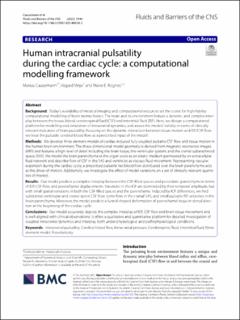Human intracranial pulsatility during the cardiac cycle: a computational modelling framework
Journal article, Peer reviewed
Published version

View/
Date
2022Metadata
Show full item recordCollections
- Department of Mathematics [939]
- Registrations from Cristin [9766]
Abstract
Background
Today’s availability of medical imaging and computational resources set the scene for high-fidelity computational modelling of brain biomechanics. The brain and its environment feature a dynamic and complex interplay between the tissue, blood, cerebrospinal fluid (CSF) and interstitial fluid (ISF). Here, we design a computational platform for modelling and simulation of intracranial dynamics, and assess the models’ validity in terms of clinically relevant indicators of brain pulsatility. Focusing on the dynamic interaction between tissue motion and ISF/CSF flow, we treat the pulsatile cerebral blood flow as a prescribed input of the model.
Methods
We develop finite element models of cardiac-induced fully coupled pulsatile CSF flow and tissue motion in the human brain environment. The three-dimensional model geometry is derived from magnetic resonance images (MRI) and features a high level of detail including the brain tissue, the ventricular system, and the cranial subarachnoid space (SAS). We model the brain parenchyma at the organ-scale as an elastic medium permeated by an extracellular fluid network and describe flow of CSF in the SAS and ventricles as viscous fluid movement. Representing vascular expansion during the cardiac cycle, a prescribed pulsatile net blood flow distributed over the brain parenchyma acts as the driver of motion. Additionally, we investigate the effect of model variations on a set of clinically relevant quantities of interest.
Results
Our model predicts a complex interplay between the CSF-filled spaces and poroelastic parenchyma in terms of ICP, CSF flow, and parenchymal displacements. Variations in the ICP are dominated by their temporal amplitude, but with small spatial variations in both the CSF-filled spaces and the parenchyma. Induced by ICP differences, we find substantial ventricular and cranial-spinal CSF flow, some flow in the cranial SAS, and small pulsatile ISF velocities in the brain parenchyma. Moreover, the model predicts a funnel-shaped deformation of parenchymal tissue in dorsal direction at the beginning of the cardiac cycle.
Conclusions
Our model accurately depicts the complex interplay of ICP, CSF flow and brain tissue movement and is well-aligned with clinical observations. It offers a qualitative and quantitative platform for detailed investigation of coupled intracranial dynamics and interplay, both under physiological and pathophysiological conditions.
